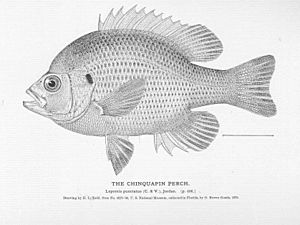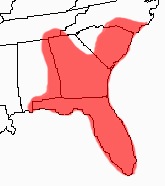Spotted sunfish facts for kids
Quick facts for kids Spotted sunfish |
|
|---|---|
 |
|
| Conservation status | |
| Scientific classification | |
| Synonyms | |
|
Bryttus punctatus Valenciennes, 1831 |
The spotted sunfish (Lepomis punctatus) is a type of freshwater fish that belongs to the sunfish family, called Centrarchidae. It's closely related to other sunfish like the redspotted sunfish, redear sunfish, and pumpkinseed sunfish.
This fish is usually olive-green to brown. It has black or reddish spots at the base of each scale, which form rows of dots along its sides. Its scientific name, punctatus, actually means "spotted," referring to these marks. A scientist named Valenciennes first described it in 1831.
Spotted sunfish live in warm waters in the Southeastern United States. They prefer areas where the water moves slowly, like streams, rivers, and swamps. They usually eat insects from the bottom of the water. Most spotted sunfish are small, often less than 10 centimeters (about 4 inches) long and weighing around 3 ounces. Sometimes, people catch them for food, as they are considered a good "pan fish" (meaning they fit well in a frying pan!).
The IUCN says the spotted sunfish is a "Least Concern" species. This means it's not in danger of disappearing and isn't very sensitive to changes in its home. Scientists think it could be used as an "indicator species," which means it can help show how healthy a stream or river is.
Contents
Where Spotted Sunfish Live
The spotted sunfish lives in warm, subtropical areas of the Southeastern United States. You can find them in rivers and coastal areas from North Carolina down to western Florida. Their northernmost home is in southern Tennessee.
These fish are most common below what's called the "Fall Line," which is a natural boundary where rivers drop from higher land to lower coastal plains. While they are doing well in states like Tennessee, Alabama, and Georgia, they are a bit more vulnerable in North Carolina. No spotted sunfish have been found living outside their natural home range.
What Spotted Sunfish Eat
Spotted sunfish mostly eat insects throughout their lives. They especially like insect larvae that live at the bottom of the water, like midge larvae. They also eat insects that fall onto the water's surface. Fishermen sometimes catch them using crickets or worms.
These fish also eat tiny crustaceans, which are like small shrimp, such as amphipods and cladocerans. Spotted sunfish catch their food by using suction, pulling the prey into their mouths. Different types of sunfish might eat similar things, but their jaws are shaped differently, so one might be better at catching certain prey than another.
Spotted Sunfish Habitat
Even though spotted sunfish can live in many different places, they do have favorite spots. Young and adult fish often choose similar homes. They like slow-moving streams, rivers, swamps, and parts of estuaries (where rivers meet the sea) that aren't too salty.
They especially like lake bottoms that have a lot of plants. They also prefer areas with limestone, sand, and gravel at the bottom. The Southeastern United States often has acidic rain, which can make the water more acidic. However, spotted sunfish seem to do best in neutral or slightly basic water. If their habitat becomes too acidic, it could harm them.
Spotted sunfish usually grow to about 9.8 centimeters (3.86 inches) long, but some have been found as long as 20 centimeters (7.87 inches). They commonly weigh around three ounces.
Life Cycle and Reproduction
Spotted sunfish usually lay their eggs from May to August in shallow water where there's plenty of cover, like plants or rocks. Male sunfish build nests, either by themselves or in groups. A single male might have several females lay eggs in his nest. Sometimes, a female has to try a few times before the male lets her into the nest.
The eggs are a bluish color. The male guards the eggs until they hatch and the baby fish, called fry, swim away. Young sunfish grow about 3.3 centimeters (1.3 inches) in their first year. Like other sunfish, they become old enough to have their own babies after about two years. On average, a female lays about 15,000 eggs. Spotted sunfish usually don't live longer than five years. They have also been known to mix with bluegill and create hybrid fish.
Males of the spotted sunfish can show two different ways of breeding. A "bourgeois" male builds a nest, attracts females, and guards the eggs. "Parasitic males" (sometimes called satellite males) try to sneak in and fertilize eggs in another male's nest, leaving the guardian male to do all the work of guarding. These parasitic males often look smaller and less noticeable, sometimes even looking like females or young fish. This "female mimicry" might help them get into a nest. Interestingly, female sunfish prefer nests that already have other females in them.
Even though nearly half of the nests might show signs of parasitic males, most of the baby fish are still fathered by the single guardian male. When there are many nests close together, a guardian male might even fertilize eggs in nearby nests if he gets a chance. Studies have shown that most nests contain eggs from at least three females, and often five or more!
Protecting Spotted Sunfish
The spotted sunfish is not a threatened species, so there aren't specific programs just for them. However, improving the general health of their habitats helps them and many other species. Because they are common, scientists often study spotted sunfish to learn more about all sunfish.
They don't have much value for commercial fishing or sport, except as a "pan fish." They are known to be feisty and have firm meat. General efforts to manage sunfish populations are usually enough to keep spotted sunfish healthy. However, if people manage habitats too intensely for other popular sport fish, it could accidentally harm the spotted sunfish.
One big threat to sunfish, including the spotted sunfish, comes from invasive cichlid fish that were often released from aquariums. These cichlids, like the Rio Grande cichlid, can be aggressive towards sunfish and even take over their nesting spots. Several types of cichlids have become established in the Southeastern United States, especially in the Everglades. These include the firemouth cichlid, convict cichlid, Mayan cichlid, and Salvin's cichlid. It's important to watch these invasive species and remove them if possible.
Scientists think that as the climate gets warmer, the areas where invasive cichlids can live might grow. It's important to keep an eye on how these invasive fish affect spotted sunfish. This information could help protect all types of sunfish.



